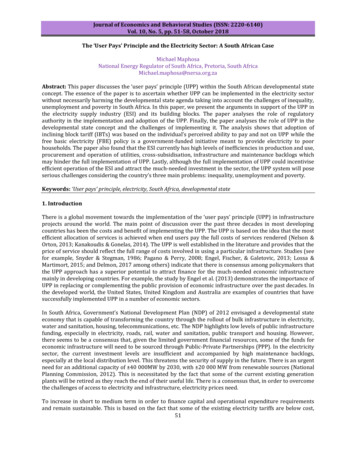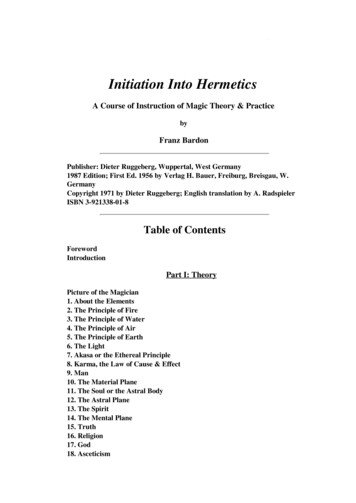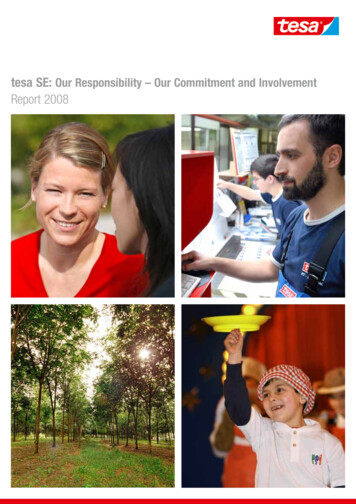
Transcription
Journal of Economics and Behavioral Studies (ISSN: 2220-6140)Vol. 10, No. 5, pp. 51-58, October 2018The ‘User Pays’ Principle and the Electricity Sector: A South African CaseMichael MaphosaNational Energy Regulator of South Africa, Pretoria, South AfricaMichael.maphosa@nersa.org.zaAbstract: This paper discusses the ‘user pays’ principle (UPP) within the South African developmental stateconcept. The essence of the paper is to ascertain whether UPP can be implemented in the electricity sectorwithout necessarily harming the developmental state agenda taking into account the challenges of inequality,unemployment and poverty in South Africa. In this paper, we present the arguments in support of the UPP inthe electricity supply industry (ESI) and its building blocks. The paper analyses the role of regulatoryauthority in the implementation and adoption of the UPP. Finally, the paper analyses the role of UPP in thedevelopmental state concept and the challenges of implementing it. The analysis shows that adoption ofinclining block tariff (IBTs) was based on the individual’s perceived ability to pay and not on UPP while thefree basic electricity (FBE) policy is a government-funded initiative meant to provide electricity to poorhouseholds. The paper also found that the ESI currently has high levels of inefficiencies in production and use,procurement and operation of utilities, cross-subsidisation, infrastructure and maintenance backlogs whichmay hinder the full implementation of UPP. Lastly, although the full implementation of UPP could incentiviseefficient operation of the ESI and attract the much-needed investment in the sector, the UPP system will poseserious challenges considering the country’s three main problems: inequality, unemployment and poverty.Keywords: ‘User pays’ principle, electricity, South Africa, developmental state1. IntroductionThere is a global movement towards the implementation of the ‘user pays’ principle (UPP) in infrastructureprojects around the world. The main point of discussion over the past three decades in most developingcountries has been the costs and benefit of implementing the UPP. The UPP is based on the idea that the mostefficient allocation of services is achieved when end users pay the full costs of services rendered (Nelson &Orton, 2013; Kanakoudis & Gonelas, 2014). The UPP is well established in the literature and provides that theprice of service should reflect the full range of costs involved in using a particular infrastructure. Studies (seefor example, Snyder & Stegman, 1986; Pagano & Perry, 2008; Engel, Fischer, & Galetovic, 2013; Lossa &Martimort, 2015; and Delmon, 2017 among others) indicate that there is consensus among policymakers thatthe UPP approach has a superior potential to attract finance for the much-needed economic infrastructuremainly in developing countries. For example, the study by Engel et al. (2013) demonstrates the importance ofUPP in replacing or complementing the public provision of economic infrastructure over the past decades. Inthe developed world, the United States, United Kingdom and Australia are examples of countries that havesuccessfully implemented UPP in a number of economic sectors.In South Africa, Government’s National Development Plan (NDP) of 2012 envisaged a developmental stateeconomy that is capable of transforming the country through the rollout of bulk infrastructure in electricity,water and sanitation, housing, telecommunications, etc. The NDP highlights low levels of public infrastructurefunding, especially in electricity, roads, rail, water and sanitation, public transport and housing. However,there seems to be a consensus that, given the limited government financial resources, some of the funds foreconomic infrastructure will need to be sourced through Public-Private Partnerships (PPP). In the electricitysector, the current investment levels are insufficient and accompanied by high maintenance backlogs,especially at the local distribution level. This threatens the security of supply in the future. There is an urgentneed for an additional capacity of 40 000MW by 2030, with 20 000 MW from renewable sources (NationalPlanning Commission, 2012). This is necessitated by the fact that some of the current existing generationplants will be retired as they reach the end of their useful life. There is a consensus that, in order to overcomethe challenges of access to electricity and infrastructure, electricity prices need.To increase in short to medium term in order to finance capital and operational expenditure requirementsand remain sustainable. This is based on the fact that some of the existing electricity tariffs are below cost,51
Journal of Economics and Behavioral Studies (ISSN: 2220-6140)Vol. 10, No. 5, pp. 51-58, October 2018with most based on the individual’s ability to pay (perceived affordability) rather than on the ‘user pays’principle. However, there is a fundamental turning point regarding the funding of infrastructure projectsaround the developing world. Recently, the World Bank, as the largest development finance institution,declared that no funds would be advanced to ESI projects in developing countries unless tariffs reflect thetrue underlying costs of supply (Patterson, 2013). Our approach in this study entails a detailed analysis of themain characteristics of the electricity supply industry (ESI) in South Africa as well as governmentpolicies/plans that anchor the industry. Our analysis of the ESI focuses more on the role of utilities andcustomers and the key challenges (capacity and inefficiencies) faced by the ESI, whilst our attention togovernment policies/plans focuses on the National Development Plan (NDP), Integrated Energy Plan (IEP)and Integrated Resources Plan (IRP), free basic electricity (FBE), Electricity Pricing Policy (EPP), etc.Furthermore, we review international best practices on the ‘user pays’ pricing approach (UPP) and map outpossible approaches for its successful implementation and propose reasons why the UPP is necessary forSouth Africa. Importantly, we establish the key relationships between FBE, inclining block tariffs, costreflectivity and the ‘user pays’ approach implementation in an environment of high inequality,unemployment and poverty. This paper, therefore, discusses the ‘user pays’ principle in detail, focusing on itsimplementation in the electricity industry. The paper provides reasons why the ‘user pays’ approach makessense for South Africa, outlines its building blocks, summarises the role of the economic regulator, and looksat the ‘user pays’ principle versus the developmental state. The paper then draws conclusions and givesrecommendations.2. The ‘User Pays’ Pricing ApproachLiterature suggests that UPP is the most practical solution for promoting equity, efficiency and sustainabilityin most economic sectors. The UPP is mostly used to collect revenue from road infrastructure financing,transport congestion management, environmental management, etc. However, the implementation of the UPPsystem has proved to be difficult, especially in developing countries with high levels of inequality,unemployment, poverty and low growth. The successful implementation requires extensive support fromgovernment and politicians, as well as customer/end-user education on the costs and benefits. In the ESI, theprice of electricity is normally a function of available capacity where excess or underinvestment hasconsequences (Kirschen & Strbac, 2004). Excess capacity leads to high prices while on the other handunderinvestment also leads to high prices, supply shortages and disruptions in economic activity. Kirschenand Strbac (2004) argued that allowing regulated utilities to recover their full cost of capacity investmentenables them to remain sustainable in the medium to long-term. However, they also suggest that this does notnecessarily guarantee that the investment made is economically optimal. Other studies suggest that the mostefficient way of limiting further infrastructure-induced price increases is through UPP, which incentivisesinvestors/utilities to be efficient in infrastructure procurement and operation, while at the same timeincentivising consumers to shift their demand from peak to off-peak periods (Hall, Jeanneret & Rai, 2016).Hall, Jeanneret, and Rai (2016) indicate that, in most instances, knowledge of their consumption empowersusers to maximise the potential benefits of cost-reflective pricing. Nijhuis, Gibescu and Cobben (2017) furtherhighlight that the UPP system penalises those users that put a greater strain on the system. In matureelectricity markets, the UPP system has been successfully used as a new approach to congestion management.User Pays’ Pricing Approach and Cost-reflective Tariffs: The UPP approach is premised on the fact thatthe price paid by end users signals the true costs of electricity supply. Kirschen and Strbac (2004) indicatethat electricity tariffs should be equal to the long-term marginal costs of supplying electricity to all customerclasses. The tariff that users pay should signal to them the costs that their decisions impose on the electricitysystem and society. In other words, users should be exposed to the consequences of their consumption.Tariffs that mirror the true costs promote efficient investment in electricity infrastructure and innovativetechnology (Maphosa & Mabuza, 2016). Recently, Hobmann, Frederiks, Stenner and Meikle (2016) suggestedthat a solution to the current disparities is to move electricity tariffs closer to the actual costs incurred byutilities to provide users with a price signal that accurately conveys the true costs of power generation.However, the efficiency of the costs incurred in supplying electricity is also important in achieving this goal.The importance of cost-reflective electricity tariffs is well recognised around the world. In South Africa, this isrecognised through the Electricity Pricing Policy (2008) which states that ‘electricity prices should reflect52
Journal of Economics and Behavioral Studies (ISSN: 2220-6140)Vol. 10, No. 5, pp. 51-58, October 2018efficient market signals, accurate cost of supply and concomitant price levels that would ensure the financialviability of the electricity sector in its entirety’. There is a consensus that there are disparities between theactual costs incurred by utilities and the tariffs charged to some users. Suggestions to migrate from theperceived non-cost-reflective tariffs to cost reflectivity date back to 2004. However, target dates set haveconstantly been shifted from the initial target of 2013 to 2015 and then 2019, owing to difficulties inbalancing access and affordability of energy services. From a regulatory perspective, setting tariffs requires abalance between a number of competing objectives i.e. economic efficiency, revenue sufficiency, fairness andequity, social orientation of electricity, simplicity, transparency and consistency with government policy. Thetariffs must be set in such a way that they establish the efficient costs incurred by utilities to cover theirprudently incurred operational (Opex) and capital expenditure (Capex) costs. Furthermore, the tariff shouldestablish the share of Opex and Capex costs to be recovered through user charges versus the ones to besubsidised, i.e. through government subsidies.User Pays’ versus Inclining Block Tariffs (IBTs) and Free Basic Electricity (FBE): In an effort to ensureaccess to affordable, reliable, sustainable and modern energy for all, South Africa adopted the free basicelectricity (FBE) policy and later the inclining block tariffs (IBTs). The FBE policy was developed in 2003mainly to provide indigents with the free electricity deemed necessary to support their basic energy needs.FBE facilitates the provision of basic energy to poor households to address the socio-economic issues ofinequality, unemployment and poverty. The FBE programme is funded through the South Africangovernment’s equitable share grant, which funds the FBE programme. FBE varies from one local distributorto the other; however, the majority of distributors provide 50kWh/month per indigent household. On theother hand, IBT is a residential tariff structure that seeks to make electricity affordable to low-incomehouseholds by providing lower tariffs for low consumption. The IBT is divided into four consumption blockswith each block having a different tariff per kilowatt-hour (kWh) of energy consumed. The first IBT blocknormally corresponds with the 50kWh FBE allocation per month. Another important feature of the IBT tariffsis that they allow for cross-subsidisation of low-income users by other customer categories, i.e. high-incomehouseholds, industrial and commercial. Some have also urged that IBTs promote energy efficiency to a certainextent through higher charges for higher consumption.However, both the FBE policy and IBT approach are based on perceived affordability (the individual’s abilityto pay) and promotion of access to affordable electricity and do not address the sustainability of theelectricity industry. Tariffs charged under both approaches do not reflect the true costs of consumption –government funds the 50kWh FBE, while the IBT rates are cross-subsidised by other customer categories.Various studies show that cross-subsidisation is not a long-term solution to affordability since most of thehigh energy-intensive users meant to subsidise low-income consumers are slowly switching to off-gridsolutions in South Africa (Willems & Ehlers, 2008; Maphosa & Mabuza, 2016). Financial sustainability andelectricity provision is affected in local distributors mainly dominated by users on the IBT structure. Themain arguments in support of moving towards the ‘user pays’ principle for these users are a locativeefficiency, covering costs incurred in a generation, fiscal and monetary objectives, incentivising investment,price stability and environmental sustainability.Why ‘User Pays Makes Sense for South Africa: The South African electricity sector is characterised by anumber of challenges. Some of these challenges emanate from the utilities, while others are from the users ofelectricity. It is our view that the introduction of a full user pays pricing approach will help address some ofthese challenges. At the top of the agenda is the high level of inefficiency in the usage of electricity by varioususers in South Africa. Appropriate implementation of ‘user pays’ tariffs can help change South Africanconsumers’ behaviour in various sectors. Importantly, in Sydney, Australia, laid (2001) found that theimplementation of the ‘user pays’ pricing principle in Sydney’s water sector resulted in the indefinitedeferment of a proposed new dam on the Shoal Haven River due to a 20% decline in overall waterconsumption. High levels of inefficiencies in the procurement and operation of utilities in the country alsoexist. Recently, there has been a heated debate among electricity consumers and the public at large oninefficiencies (imprudent costs) and the perceived irregular expenditure on some capital and operation costs.The argument is that these inefficiencies have far-reaching negative effects on households and firms whichare dependent on them as their only energy source. Delays and subsequent cost overruns in some instances53
Journal of Economics and Behavioral Studies (ISSN: 2220-6140)Vol. 10, No. 5, pp. 51-58, October 2018result in the overstatement of the regulatory asset base (RAB), which results in higher revenue request byutilities. It has also been argued that, in some instances, consumers pay the price for utilities’ inefficiencies. Itis our view that isolating the true underlying costs of electricity, excluding inefficiencies, will pave the way forthe full implementation of the ‘user pays’ principle.Currently, there is no mechanism in place to validate the extent of non-cost-reflectivity of tariffs in the ESI.Compounding the problem is also the high level of cross-subsidisation in the ESI, which Maphosa and Mabuza(2016) argued against in light of their long-term sustainability. Therefore, cross-subsidies are a short-termsolution that should be used while addressing the inefficiencies in the industry. The high levels of electricityinfrastructure maintenance and refurbishment backlogs also pose a challenge to the industry. The electricitydistribution infrastructure is estimated to be 40 years old with the majority of it requiring majorrefurbishment or replacement. In this regard, the UPP approach would assist in attracting investment toeradicate or reduce these backlogs. The government’s fiscal budget is unable to fund all highly capitalintensive infrastructure projects adequately on its own. Proper implementation of the UPP will incentivisethe private sector to partner with government to address this challenge. Positive economic benefits havealready been seen in various sectors where the ‘user pays’ approach has been implemented, for example innational roads, public transport (Gautrain), water (raw water), national environment management, prisonsand office blocks.However, since electricity consumers in South Africa view electricity as a public good, the implementation ofsuch an approach in the ESI might pose serious challenges due to the three problems mentioned above.Although the NDP concedes that tariffs should increase in short to medium term to fund capital expenditureand maintenance programmes, it is not quite clear whether tariffs are indeed low, taking into considerationthe level of inefficiencies in the capital and operational expenditure discussed above. Furthermore, anotherpart of the debate is the notion that state-owned utilities, for example Eskom, should not be allowed by theregulator to earn a profit. Consumers do not understand the need to pay high tariffs that are equivalent totheir strain on the electricity grid. However, Patterson (2013) rejects this notion and argues that as much asprivate entities are allowed to earn profits, so are state-owned utilities for them to remain self-sustainableand avoid over-reliance on government bailouts. The NDP also supports this view by conceding thatelectricity tariffs need to increase in short to medium term to fund capital expenditure and maintenanceprograms.Building Blocks: ‘User Pays’ Principle: There are various ways to promote efficiency, equity andsustainability in the electricity sector and the ‘user pays’ approach is the simplest in theory, but very difficultto implement in practice (Rogers, De Silva & Bhatia, 2002). In this section, we propose possible buildingblocks for the successful implementation of the ‘user pays’ approach in the ESI. A rigorous publicparticipation process before and during the construction of infrastructure projects, e.g. power stations, isrequired. The UPP requires the provision of adequate information related to costs and benefits of everyproject undertaken, especially the ones to be paid for by users. These costs and benefits must be properlyarticulated to encourage user buy-in. However, in South Africa, the procurement and construction of powerstations are not under the ambit of the regulator, therefore the enforcement of efficiency in these projectsposes a slight challenge. It is recommended that a body like a regulator responsible for tariff/price setting inthe ESI should also be responsible for awarding construction tenders and oversee the procurement of assetsto enforce efficiency. An open competitive bidding process in the procurement of utility assets is important inconvincing electricity users. Again, the bidding process should be open to all stakeholders and their inputsproperly considered in making the final decision. Ideally, this process should lead to the selection of the mostcapable service provider.Furthermore, transparency during the construction phase is also important in order to keep users abreast oftimelines, possible delays and any foreseeable cost escalations. This should be done to demonstrate that duecare is applied at all times and that any inefficiencies are identified and corrected without affecting projecttimelines. Importantly, both utilities and government need to manage perceptions and misconceptions aboutparticular projects actively, for example, affordability, corruption, beneficiaries, the full disclosure of all costsincurred, subcontractors, and their shareholders. The costs and benefits of such projects should be properly54
Journal of Economics and Behavioral Studies (ISSN: 2220-6140)Vol. 10, No. 5, pp. 51-58, October 2018motivated to prepare users in advance. Lastly, the general political will is a critical factor needed for properimplementation of the UPP system. Williams (1995) opined that the nature of infrastructure funding systemsis solely dominated by political considerations.3. The Role of the RegulatorAvailable electricity literature shows that the price that users pay is a function of the capacity in the system(Patterson, 2013). If electricity utilities are allowed to build too much generation capacity, the electricityusers ultimately pay more for unused capacity. However, if too little capacity is built, the electricity networkwill be congested, leading to load shedding, price increases and ultimately, low economic growth. It is,therefore, important to recognise the role of the regulator like the one of striking a balance betweengeneration capacity and prices. The uncertainties between demand and generation create a difficult task forregulators. Regulators should be constantly aware of the costs and benefits of both under-and overinvestment in generation capacity to determine the efficient price. Furthermore, the role of the regulator is toimplement tariff structures that eliminate inefficiencies in the usage of electricity as provided by governmentpolicies; for example, in South Africa, the Electricity Pricing Policy (EPP) is important in this regard. It is ouropinion that the successful implementation of the UPP requires the regulator to rigorously develop andimplement prudency rules around procurement, construction and operation costs of utilities. These rulesshould clearly state how inefficiencies, construction delays, cost overruns and a lack of due diligence byutilities will be penalised. Importantly, efficiency must also be instilled in the day-to-day operations ofutilities to isolate prudently incurred costs from inefficient costs. Regulatory mechanisms should also be inplace to protect users from paying for utilities’ inefficiencies.Recent studies (see, for example, Ouyang & Sun, 2015; Nazemi & Mashayekhi, 2015) stressed thatinefficiencies distort pricing and affordability levels in electricity regulation around the world. The regulatorneeds to develop frameworks to classify and disqualify costs imprudently incurred to instil confidence inusers and possibly encourage them to accept a full UPP as a future useful method of payment of electricity. Onthe other hand, this will also encourage utilities to be more efficient in their capital and operationalexpenditure. Proper classification and disqualification of costs might possibly instil confidence in consumersabout the work of the regulator and encourage users to consider moving towards the full ‘user pays’ system.Procedures and methodologies for the evaluation and revaluation of the RAB must be reinforced.Regulating utilities in terms of a rate of return methodology may, in some instances, encourage the utilities tooverstate their RAB to increase the allowed revenue collected from end users (Kirschen & Strbac, 2004). Thegradual movement towards a full ‘user pays’ system must be encouraged to eliminate cross-subsidisation.Although cross-subsidies are important for equity reasons, they are considered highly inefficient andregressive; therefore, they should be gradually phased out to relieve the subsidising population(Chattopadhyay, 2004; Fattouh & El-Katiri, 2013; Maphosa & Mabuza, 2016). Studies show that crosssubsidisation is gradually moving industrial and commercial users towards off-grid solutions, while othershave also considered downscaling or relocating their operations. In reality, the subsidising population isslowly shrinking, while the subsidised population is ever increasing.‘User Pays’ and the ‘Developmental State’: The ‘developmental state’ concept is not new in the developingworld. It is a concept that was developed in policy discussions regarding the three problems – unemployment,inequality and poverty (Burger, 2014). The ‘developmental state’ concept is therefore linked to high levels ofeconomic growth and large infrastructure projects that grow at rapid rates, for example, Japan and China inthe 1980s and Brazil in the 2000s. In South African, the National Development Plan (2012) proposed the ideaof transforming South Africa into a ‘developmental state’ through massive capital-intensive infrastructureconstruction. The plan envisaged aggressive savings channelled for industrialisation to reduce inequality,unemployment and poverty in South Africa. One of the key building blocks identified in the NDP is to workwith the private sector in building the required bulk infrastructure, mainly in the economic sectors. Giventhat South Africa lags behind in infrastructure investment, there is a serious need to induce high levels ofcapital spending, especially in the electricity and the energy sector.55
Journal of Economics and Behavioral Studies (ISSN: 2220-6140)Vol. 10, No. 5, pp. 51-58, October 2018In the absence of adequate funds for expanding and maintaining electricity infrastructure, the ‘user pays’system offers a meaningful approach that can drive electricity sector growth. In other words, the ‘user pays’approach offers potential benefits that can be harnessed in the electricity sector. There is an estimated grossfixed capital formation of 30% of GDP required by 2030 to realise sustained growth; however, this will not bepossible through state-led funding alone. Statistics show that there is an overreliance on government to fundall required infrastructure. However, due to low economic growth over the past five years, approximatelyonly 10% of the population contribute to government revenue through taxation (National Treasury, 2015).The introduction of the full UPP can potentially bridge the ESI funding gap and transform into a selfsustainable industry capable of transforming the economy. It could help attract the much needed privatesector investment to meet the 40 000 MW additional capacity by 2030, of which approximately 20 000 MW isenvisaged to come from renewable energy sources. Furthermore, this will help to address the hugemaintenance backlogs, especially at the local distribution.4. Summary of ResultsOur analysis shows that, first, the ’user pays’ principle is the most practical, promoting equity, efficiency andsustainability in the ESI. This is reinforced by recent seminal works of Hall et al. (2016) and Nijhuis et al.(2017). The UPP approach is successful in limiting further infrastructure-induced tariff increase since itincentives consumers to change their consumption behaviour. Second there is a strong link between costreflectivity and UPP. Both principles are premised on end-users paying the actual costs of the strain theyimpose on the system (i.e. tariff paid must be equal to the long-term marginal costs). This is confirmed byKirschen and Strbac (2004), Maphosa and Mabuza (2016) and Hobmann et al. (2016). Importantly, there isrecognition in South Africa through the EPP that cost reflectivity is important for the sustainability of the ESI.There is a need to strike a balance between access and affordability in order to achieve cost-reflective tariffs.Third, we observe that both the FBE policy and IBTs are approaches based on perceived affordability (theindividual’s ability to pay) and only centred on the promotion of access to affordable electricity and do notaddress the sustainability of the ESI. The two are anchored by government funding and cross-subsidisationrespectively and raise sustainability problems. This is confirmed by Willems and Ehlers (2008) and Maphosaand Mabuza (2016) in similar studies. The benefit of this is that the government can focus on other prioritiesareas, such as building social infrastructure related to health care, social welfare, housing, etc.Fourth, the implementation of the UPP approach is ideal for South Africa, especially for the ESI. The UPP willhelp address all the inefficiencies and challenges raised above (i.e. usage, procurement and utility operation).Furthermore, the UPP will help attract the much needed private investment into the ESI. Fifth, although veryeffective, the implementation of UPP in a developing country suffering from the three main problems(inequality, unemployment and poverty inequality) would pose serious challenges. A rigorous publicparticipation process would be required and political will to secure the buy-in by end users. Sixth, the role ofthe regulator should be reinforced in issues around procurement of utility assets, construction and utilityoperations. Modern regulatory instruments are required to enforce compliance. This analysis is in line withOuyang and Sun (2015) and Nazemi and Mashayekhi (2015), who stressed that protection of end users fromutilities’ inefficiency was important. Finally, the UPP system is useful in attracting the much needed privateinvestment to bridge the funding gap in the ESI to enable the government to fund social infrastructure in thecountry.5. Conclusion and RecommendationsThis paper analysed the ‘user pays’ principle within the South African developmental state concept. Theobjective was to ascertain whether UPP can be implemented in the electricity sector without necessarilyharming the developmental state agenda, taking into account the challenges of inequality, unemployment andpoverty in South Africa. We examined the interplay between UPP, free basic electric
Keywords: 'User pays' principle, electricity, South Africa, developmental state 1. Introduction There is a global movement towards the implementation of the 'user pays' principle (UPP) in infrastructure projects around the world. The main point of discussion over the past three decades in most developing










